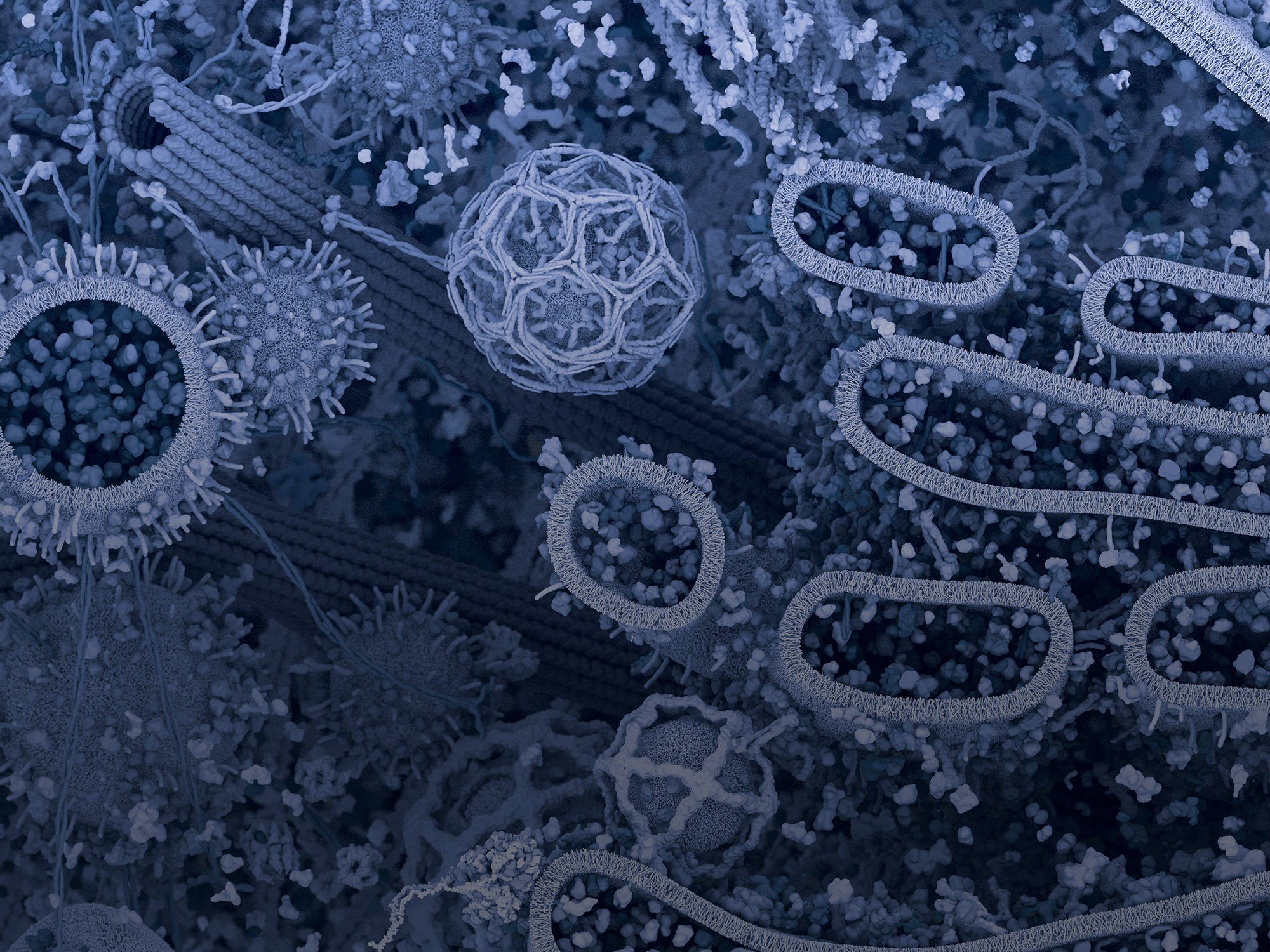In order to quickly defeat SARS-CoV-2 (severe acute respiratory syndrome-coronavirus-2,previously named as nCoV) and stop the epidemic, diagnosis and treatment are especially important. As of January 31, 2020, SARS-CoV-2 nucleic acid detection kits from seven companies have been approved for SARS-CoV-2 detection. Meanwhile, researchers are still working hard to develop effective treatments.

Researcher Hao Pei of Shanghai Pasteur Institute of Chinese Academy of Sciences (and others) utilized computer simulation analysis to report that because the spike protein on SARS-CoV-2 is similar in spatial structure to that of SARS virus, it is presumed that it may also enter the host cell by binding to the human cell surface receptor ACE2, while MERS-CoV enters the host cell using DPP4.[1] ACE2 is a protein that balances ACE/AngII bioactivity in the renin-angiotensin signaling pathway. Inhibition of this pathway can reduce the effect of SARS, which also utilizes ACE2, and in experiments with mice it reduced lung injury caused by the SARS-S protein. [2]
However, more studies are needed to confirm whether ACE2 is the sole avenue for SARS-CoV-2 to enter a host cell. After SARS-CoV-2 enters a cell through ACE2 and undergoes endocytosis, cathepsin then degrades the spike protein (S protein) to release the nucleic acids of the virus. Some evidence shows that cathepsin B/L inhibitor can block this process. This study also showed that SARS-CoV-2 can be directly cleaved by the transmembrane protein TMPRSS2, and viral entry into the cell was blocked by using a TMPRSS2 antagonist. [3]
At present, some of the world’s leading biotech companies and research institutions have announced their participation in the exploration and development of a vaccine against SARS-CoV-2. Clinical trials to test potential drug treatments are now being carried out based on the following strategies: First by targeting the virus: in vitro experiments are conducted to screen a batch of listed antiviral drugs, some of which have entered clinical trials, such as fabiravir, lopinavir, and ritonavir; Phase III clinical study of adenosine analogue Remdesivir has been initiated. Second, by targeting the host cells: small molecule interferons, such as chloroquine and nitazoxanide, are being tested [4]; Additionally, inhibitors, such as Baricitinib, Sunitinib, Erlotinib, are being examined using artificial intelligence programs in an attempt to identify compounds that can restrict host cell mechanisms of endocytosis, growth, and viral assembly [5].
CST has well-validated research antibodies and small molecule compounds, which can help researchers unveil the pathogenesis of viral disease and advance research and development of assays and therapeutic drugs.
Antibodies Against the Host Protein
|
Target |
Catalog |
Product Name |
Application |
Reactivity |
Note |
|
ACE2 |
#4355 |
Temporarily Out of Stock |
WB, IP |
H |
Host receptor of SARS-CoV-2 and SARS-CoV |
|
DPP4 |
#67138 |
WB, IP,IF |
H |
Host receptor of MERS-CoV |
|
|
#40134 |
IHC |
H |
|||
|
AAK1 |
#79832 |
WB, IP |
H M R |
Host endocytosis regulator |
|
|
Cathepsin B |
#31718 |
WB, IHC, IF, F |
H M R |
Possibly participate in the hydrolysis of coronavirus S protein, thus releasing its nucleic acid |
|
|
#59355 |
F |
H M R |
|||
|
#55279 |
Cathepsin B (D1C7Y) XP® Rabbit mAb (Alexa Fluor® 488 Conjugate) |
IF |
H M R |
||
|
#3373 |
WB |
H |
|||
|
#3383 |
WB |
H M |
|||
|
IgM |
#74293 |
WB |
H |
It can be used with SARS-CoV-2 specific antigen to detect whether there is SARS-CoV-2 specific IgM in patients' blood. |
Potential Candidate Compounds Help Understanding of Drug Effects
|
Catalog |
Name |
Note |
|
#14774 |
Lysosophilic agent which inhibits autophagy and can inhibit SARS-CoV-2 in vitro[6] |
|
|
#12328 |
Multiple tyrosine kinase inhibitors targeting PDGFR, VEGFR, KIT and FLT3 |
|
|
#5083 |
ATP Competitive Inhibitor in EGFR Kinase Pathway |
|
|
#15022 |
Epoxomycin related protease inhibitor |
In terms of the incubation period, clinical manifestations, and response to treatment, COVID-19 (the Corona Virus Disease 2019 that results from an infection with SARS-CoV-2) shares some similarities with SARS. The latest Lancet paper examined 99 patients with COVID-19 and found that the absolute value of lymphocytes in the majority of patients decreased. The results show that, like SARS-CoV, SARS-CoV-2 may mainly affect lymphocytes, especially T lymphocytes. The virus particles are thought to spread through respiratory mucosa to infect other cells where they induce cytokine storms in vivo, produce a series of immune responses, and cause changes of peripheral leukocytes and immune cells (such as lymphocytes). Some patients rapidly develop acute respiratory distress syndrome (ARDS) and septic shock, which eventually leads to multiple organ failure. [7]
Some studies suggest that a significant reduction in the total number of lymphocytes indicates that coronavirus consumes many immune cells and inhibits the cellular immune function of the human body. The damage of T-lymphocytes may be an important factor in the deterioration of patients' condition. [8]
According to an interview from Southern People's Weekly, with Dr. Zhong Ming, deputy director of the Department of Critical Medicine of Shanghai Zhongshan Hospital, COVID-19 has been shown to worsen in later stages as cytokine storm, multiple organ failure, and myocardial injury markers increased. This course of the disease is not the same as with previous SARS and avian influenza patients. SARS patients often present with serious symptoms in the beginning stages as opposed to later stages. This information suggests that the damage of T lymphocytes, and dysfunction of macrophages and NK cells may lead to cytokine storm in the later stages of the immune response. Overall, further study is needed to better understand how the host cells and other immune cells in the body respond after infection with SARS-CoV-2.
Immune Regulating Pathways Involved in Viral and Cytokine Response
Cell Intrinsic Innate Immunity Signaling
In the retrospective study on the clinical imaging features of COVID-19 [9], CT scans showed fibrotic lesions in stages such as disease progression, severe disease, and remission. Activation of the fibrosis pathway may cause damage to lung function. Keeping in mind the involvement of the ACE2 protein, more research is needed to figure out the potential damage to other organs, such as the liver and kidneys.
Fibrosis-related Pathways
ECM composition and deposition
This epidemic will eventually fade away. With the current state of international alert, it is only a matter of time before the epidemic passes. However, for the patients and medical workers involved, this battle may have just begun. Looking back at SARS, for those cured, the lung damage is only a part of the sequelae, and the more serious concerns include femoral head necrosis which may have been caused by high dose hormone therapies or other treatments. In addition, the psychological trauma experienced by SARS patients and medical workers has lasted many years after the end of the SARS epidemic. [10-13]
Necrotic Cell Death-Related Pathway
After the past 17 years of SARS, once again, SARS-CoV-2 has had a disastrous and far-reaching impact on our life and productivity. Past experience and lessons learned, if not forgotten, should be a guide for the future. Even with all that we have learned so far about the epidemiology, prevention, and possible treatment of COVID-19, we still have so much more to learn to advance our approach to controlling this epidemic.
References:
[1] Xintian Xu et al. Evolution of the novel coronavirus from the ongoing Wuhan outbreak and modeling of its spike protein for risk of human transmission.SCIENCE CHINA Life Sciences, https://doi.org/10.1007/s11427-020-1637-5
[2] Kuba, K., Imai, Y., Rao, S. et al. A crucial role of angiotensin converting enzyme 2 (ACE2) in SARS coronavirus–induced lung injury. Nat Med 11, 875–879 (2005). https://doi.org/10.1038/nm1267
[3] Hoffmann, M. et al. The novel coronavirus 2019 (2019-nCoV) uses the SARS-coronavirus receptor ACE2 and the cellular protease TMPRSS2 for entry into target cells. bioRxiv, 2020.2001.2031.929042, https://doi.org/10.1101/2020.01.31.929042
[4] Guangdi Li et al. Therapeutic options for the 2019 novel coronavirus (2019-nCoV). Nature Reviews Drug Discovery, 2020, doi:10.1038/d41573-020-00016-0
[5] Peter Richardson et al. Baricitinib as potential treatment for 2019-CoV acute respiratory disease.The Lancet In press, 2020, doi: https://doi.org/10.1016/S0140-6736(20)30304-4
[6] Remdesivir and chloroquine effectively inhibit the recently emerged novel coronavirus (2019-nCoV) in vitro. Cell Research (2020) 0:1–3; https://doi.org/10.1038/s41422-020-0282-0
[7] Nanshan Chen, Min Zhou, Xuan Dong, Jieming Qu, Li Zhang. Epidemiological and clinical characteristics of 99 cases of 2019 novel coronavirus pneumonia in Wuhan, China: a descriptive study. The LancetIn press, corrected proof. Available online 30 January 2020. https://doi.org/10.1016/S0140-6736(20)30211-7
[8] T-cell immunity of SARS-CoV: Implications for vaccine development against MERS-CoV. Antiviral Research.Volume 137, January 2017, Pages 82-92. https://doi.org/10.1016/j.antiviral.2016.11.006
[9] Novel coronavirus pneumonia in Wuhan: clinical and imaging features, radiology practice, 2019. DOI:10.13609/j.cnki.1000G0313.2020.02.001
[10] Stress and Psychological Distress Among SARS Survivors 1 Year After the Outbreak,The Canadian Journal of Psychiatry, Vol 52, No 4, April 2007,DOI:10.1177/070674370705200405
[11]1-Year Pulmonary Function and Health Status in Survivors of Severe Acute Respiratory Syndrome,CHEST, 128, 3, SEPTEMBER, 2005,DOI:S0012-3692(15)52164-8
[12] Mental Morbidities and Chronic Fatigue in Severe Acute Respiratory Syndrome Survivors Long-term Follow-up, Intern Med. 2009;169(22):2142-2147. doi:10.1001/archinternmed.2009.384
[13] SARS 10 years later: How are survivors faring now? Global News, https://globalnews.ca/news/404562/sars-10-years-later-how-are-survivors-faring-now/


